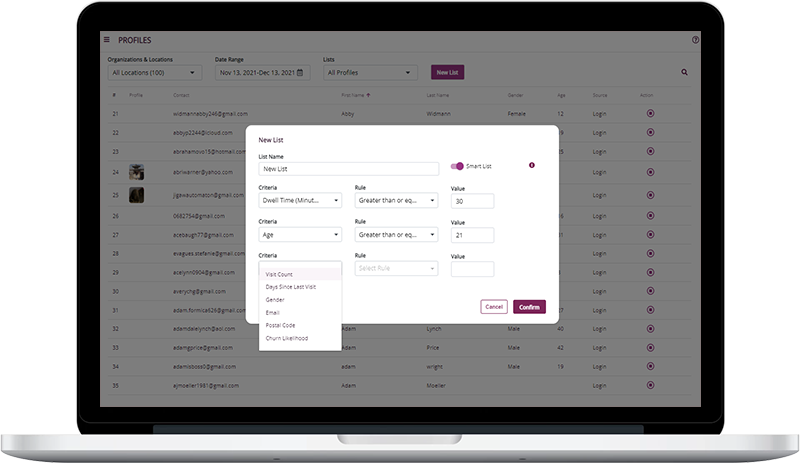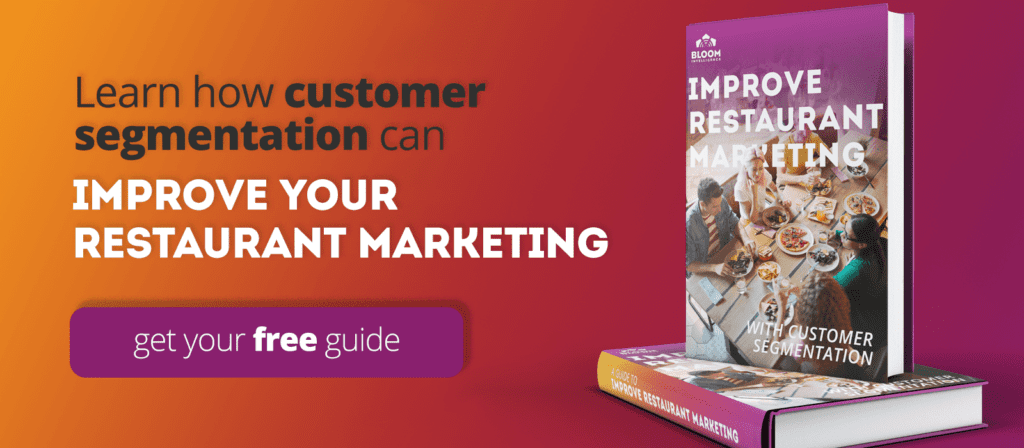As the owner or operator of a restaurant or chain, trying to decipher why a guest behaved in a certain way is almost akin to reading minds.
Taking risks is perhaps the path you took for many years in figuring out the behavior of your customers. If you accumulated basic data on these customers in the past, no doubt you just had to play hunches on catering to their actions.
Capturing accurate customer data through a captive portal eliminates mere guessing in your metrics. WiFi technology has come a long way in being able to capture more thorough, accurate, and clean customer intelligence data about your guests.
Even if your guests do not log into your WiFi, you can still gather anonymous customer data to help guide your marketing and operations strategies with data-driven decisions.
If customers do log into your WiFi – even just once – you’ll be able to market to that guest via targeted, automated marketing campaigns.
Analyzing Behavior From New and Loyal Guests
The secret to capturing this data is through a captive portal that works through your existing WiFi service. If you’ve already provided free WiFi to your customers, you can turn this into a symbiotic process.
A captive portal is simply the page that a guest is directed to when logging into your WiFi. There are many things you can do when developing a captive portal. You’ll find several examples here.
You can build customer profiles, onboard customer data onto third-party applications, and automate your marketing campaigns quickly and easily.
Once you begin collecting guest data, you might find some surprises about how your loyal patrons typically behave. Then you can adjust marketing and operations procedures to optimize your business over time.
You will see things like customer dwell times, popular days and times, age and gender distribution, customer repeat rates, postal codes, birthdates, and more.
Then, you create specific guest lists to send targeted marketing messages based on behavior and demographic data. This is known as customer segmentation and can provide a much higher ROI on your marketing efforts.
Captive Portal Data Can Power Customer Segmentation
Customer segmentation and personalization of your marketing messages is crucial in today’s competitive marketplace.
Segmentation refers to using customer data to create much more effective email content because it can be tailored for each individual or each customer persona.
Using personalized messaging has been proven to improve open rates and generate more revenue because it allows restaurant marketing professionals to create more relevant content that will more effectively pique the interest of the consumer.
By collecting customer data through your WiFi access points, and grouping those customers into separate lists, marketers can avoid sending out a single mass message in hopes that it resonates well with at least some of the audience.
Instead, they can focus on sending highly targeted messages to each customer segment, increasing open rates, and encouraging more engagement.
How to Collect Individual Customer Data
To execute an effective personalized email marketing campaign, you’ll need to have comprehensive data about your individual customers.
There are various ways in which to collect customer data, but most are either expensive or take a great deal of time and energy.
The only efficient way to gather enough comprehensive, verified data to effectively create a personalized campaign is to use a quality WiFi Analytics platform.
Using WiFi technology, you’ll be able to capture data directly from your customers when they log into your WiFi access point.
This will allow you to passively gather the necessary individual customer information required for proper personalization.
Using progressive profiling, data such as name, email address, phone number, age, gender, birthday, and other information is entered by the customer each time they log back into your WiFi.
In addition to all of this demographic information, the WiFi analytics platform also tracks the physical behavior of your customers, logging things such as dwell times, repeat visits, coupon redemption, days of the week, and hours of the day they have visited.
With this kind of thorough and reliable data, marketers can begin using it to build powerful, data-driven targeted restaurant marketing campaigns.

Using Data to Build Personalized Marketing Messages
According to research from Salesforce, the world’s #1 customer relationship management platform, data targeting and segmenting was used 51% more by overperforming businesses than those who were underperforming.
This makes perfect sense when thinking about today’s consumers. They expect personalized messaging and they quickly sniff out when they’re receiving a simple generic mass-marketing message.
The simplest way to get started creating segmented and personalized campaigns is to make your customer profile data filterable.
This will allow you to start building segments of specific customers based on their demographics and behavior data.
Segmentation for Marketing Using Customer Intelligence
It is important to be able to save these segmented lists so you don’t have to build them each time you want to send out a message.
Some examples of segmented lists might include:
- Women over 30 who visited on Mother’s Day of last year.
- Any customer who has visited more than x times.
- Customers whose average dwell time is under 20 minutes.
- Men below 45 years old who have only visited your establishment once.
- Women/Men who only visit at lunchtime.
As you can imagine, these specific audiences would likely respond best to entirely different marketing messages.
Being able to segment your customer list allows this to happen.
While building these lists, you’ll need to be brainstorming about how to effectively engage these groups.
As you go through this process, ask yourself and your team members these questions:
- What kind of action do I want this customer to take?
- What is the best way to reach this customer?
- What kind of deals or promotions would interest this customer?
- What kind of deals and promotions would this customer NOT be interested in?
- What new products or services might engage this customer?
- What are this customer’s pain points? Why do they need what I offer?
- How can I attract and engage more customers like this?
- What type of imagery would engage this customer?
Always Be Testing
 Now that you have your customer segments properly defined, and you have an idea of the marketing messages and promotions you want to send to them, it’s time to get started.
Now that you have your customer segments properly defined, and you have an idea of the marketing messages and promotions you want to send to them, it’s time to get started.
When you create and send your marketing message to each list, it is vital that you monitor the ROI of each campaign.
As initial results come in, analyze the results and keep them documented in your platform.
The next time you send a message to each group, you’ll want to make a small change to the message.
You should only make a single change to the message while testing. Send the message and compare its results to the original message.
If results are not as good as the original, go back to your original message and test a different aspect of the message.
If results are better, keep the change and continue testing and optimizing over time. This is known as A/B testing.
Also, don’t forget that you’re not just targeting current customers.
You should also be seeking out new lookalike prospects online and targeting them in an effective manner using the data you’ve collected.
These prospects should have a higher probability of becoming a new customer, providing a more cost-effective means of acquiring new customers.
Final Thoughts On Marketing Segmentation and Personalization
Segmenting and personalizing your email marketing messages with reliable customer data has been proven as an effective way to deliver relevant and engaging marketing content to your customers.
What’s most important is that captive portal data lets you set up a more targeted restaurant marketing campaign. The more you know, the more targeting you can achieve in any future marketing content you send.
This adds value to their experience and can quickly improve your open rates and subsequent revenue.
Using a WiFi marketing and analytics platform to collect a large volume of the right data, personalizing your marketing campaigns has never been easier.
You’ll feel confident as you make solid data-driven decisions, drive company growth and build a much larger base of loyal customers.
To learn more about what you can do with data captured by your captive portal, and how to save time while increasing customer lifetime values, call us today for a free demo at 727-877-8181, or click here to schedule your free demo online.





.svg)